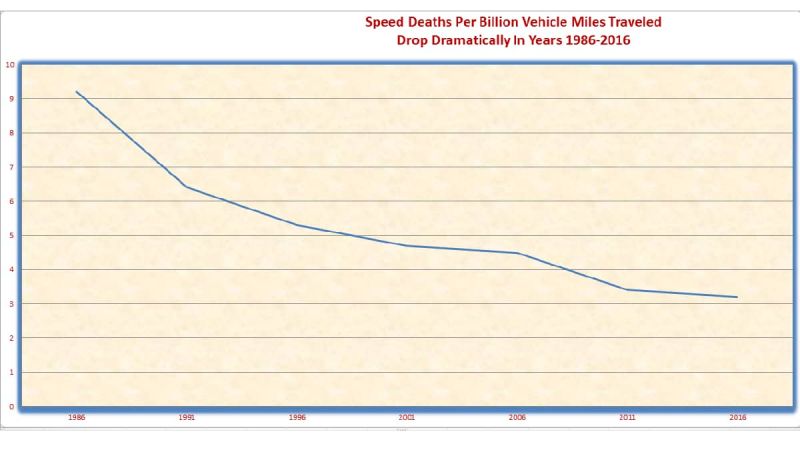The rate of deaths caused by speeding in America per mile driven has declined to one-third of the rate from the 1980s when NHTSA first began to track auto-related deaths caused by speeding. In 1986, the peak for speed-related deaths recorded in America, the rate was 9.2 deaths per billion vehicle miles traveled. That rate had dropped to just 3.2 deaths per billion vehicle miles by the year 2016.

And it isn't just the rate of deaths that has fallen. The total number of Americans killed in speed-related incidents has dropped from a high in 1986 of 16,937 to a low of 9,283 in 2014. Speed-related deaths have dropped to under 10,000 per year in the past four of five years (with 2017 being the latest year for which data is available). This despite Americans doubling their driven miles from the '80s to the present day.
Another fact makes the drop in speeding-related deaths even more significant. Many states raised their top speed limits from 55 MPH to as high as 80 MPH during the past few decades. Yet, despite the higher speed limits, speeding deaths overall continue to drop. On reason for this is that more than half of speed-related deaths occur on roadways that have a speed limit below 55 MPH. Speed itself is not the problem. Excessive speed for a given situation is.
What do you think accounts for the dramatic decline in speeding-related deaths in America? Tell us in the comments below.
For the latest fatality facts, please visit this IIHS link.
The chart below shows the total deaths per year and the speed-related deaths in that year based on police reports. It was provided by NHTSA:













Comments
I think that a lot of the
Permalink
I think that a lot of the improvement is that the average vehicle out on the road is safer today, with engineered structures to protect the occupants better, and better brakes, tires, airbags (generally), and other included safety systems like traction control, ABS, electronic stability control, plus other electronic aids like forward-collision warning, automatic emergency braking, pedestrian detection, adaptive cruise control, blind-spot warning, and lane-departure warning. Plus stiffer penalties for drunk driving means that there are fewer deaths from drunks speeding. I am happy to see that these efforts and technologies are saving lives.
Spot on. The end caps on
Permalink
Spot on. The end caps on guard rails, moving poles back and other now common practices must have had a big positive impact. "Hand of God" stability control has saved my personal butt more than once.